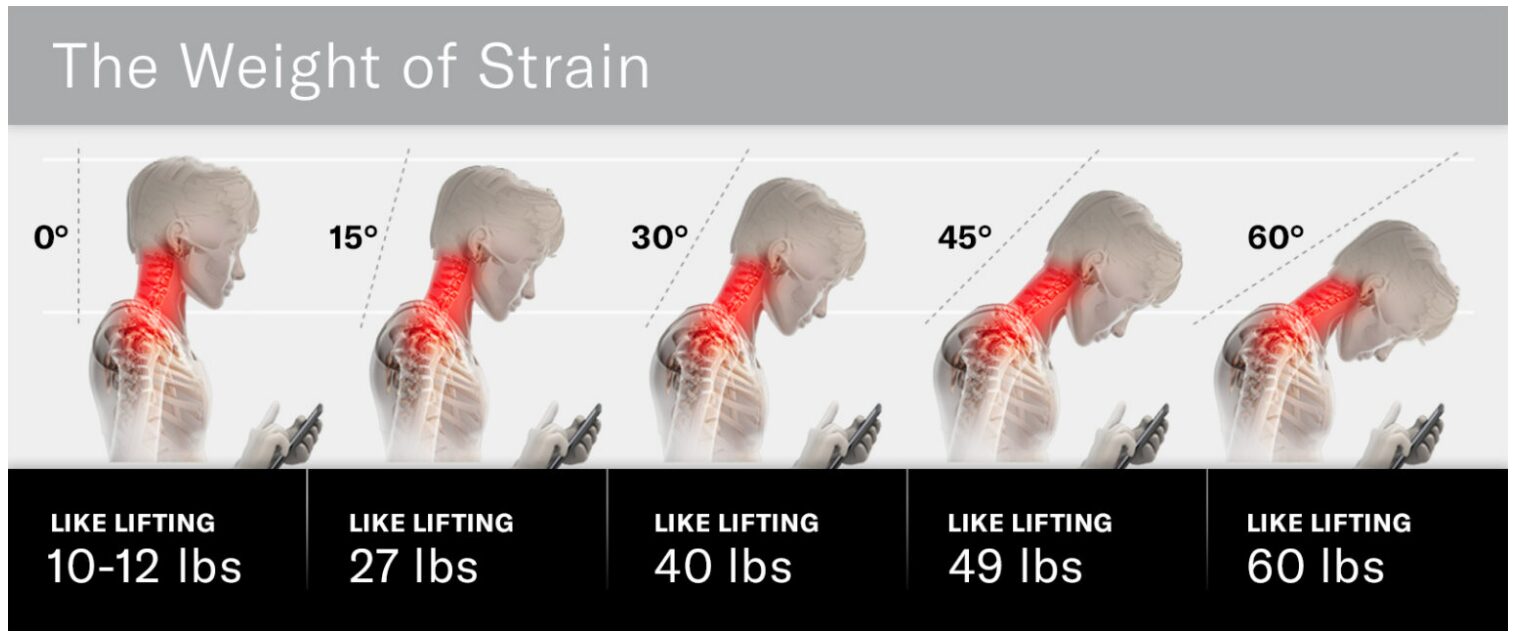Is Your Phone Hurting Your Neck?
Have you ever felt stiffness, soreness, or tension in your neck and shoulders after spending too much time on your phone? If so, you’re not alone. Millions of people suffer from chronic neck pain caused by a modern epidemic known as “tech neck”—a condition resulting from looking down at screens for prolonged periods.
With smartphones, tablets, and computers becoming an essential part of daily life, most people don’t realize how much strain they’re putting on their spine—until the pain sets in.
But here’s the good news: tech neck is preventable and treatable! By understanding the mechanics of this condition and taking the right steps, you can protect your spine, reduce pain, and improve your posture.
As chiropractors, we see patients every day struggling with neck pain, tension headaches, and poor posture—all linked to excessive screen time. This article will explore the hidden dangers of tech neck, provide research-backed insights, and share effective chiropractic solutions for long-term relief.
What is “Tech Neck”?
Tech neck, also called text neck, is a modern spinal condition caused by looking down at phones, tablets, and other screens for prolonged periods. When you tilt your head forward, the weight of your head increases stress on your cervical spine (the vertebrae in your neck), leading to pain and misalignment.
The Weight of Your Head and Its Impact on Your Spine
Your head weighs about 10-12 pounds in a neutral position, but as you tilt it forward, the pressure on your neck increases dramatically:
- 15-degree tilt = 27 lbs of pressure
- 30-degree tilt = 40 lbs of pressure
- 45-degree tilt = 49 lbs of pressure
- 60-degree tilt = 60 lbs of pressure
(Source: Hansraj, K.K. (2014). “Assessment of stresses in the cervical spine caused by posture and position of the head.” Surgical Technology International, 25, 277-279.)

Imagine carrying a 60-pound weight on your neck for several hours a day! Over time, this strain can lead to:
✅ Chronic neck pain
✅ Muscle stiffness and tension headaches
✅ Reduced range of motion
✅ Spinal misalignments (subluxations)
✅ Increased risk of herniated discs
Signs and Symptoms of Tech Neck
Tech neck doesn’t just cause discomfort—it leads to structural damage in the spine if left unaddressed. Here are common symptoms that many chiropractic patients experience:
- Neck stiffness and soreness
- Frequent tension headaches or migraines
- Upper back and shoulder pain
- Tingling or numbness in the arms and hands (nerve compression)
- Poor posture, rounded shoulders, or forward head posture
If you’re experiencing any of these symptoms, it’s time to take action before the condition worsens.
How Tech Neck Affects Your Overall Health
Your neck and spine play a critical role in your body’s overall function. When misaligned, it can impact:
1. Spinal Misalignment and Nerve Interference
Your spine houses the central nervous system, which controls everything in your body—from digestion to immune function. Spinal misalignment (subluxations) caused by tech neck can disrupt nerve signals, leading to other health issues beyond just pain.
(Source: Seaman, D.R. (2002). “The role of diet and inflammation in chronic pain.” Journal of Manipulative and Physiological Therapeutics, 25(2), 94-102.)
2. Increased Risk of Degenerative Disc Disease
Long-term forward head posture accelerates spinal degeneration, leading to conditions like herniated discs and arthritis. Studies show that increased cervical spine flexion leads to higher rates of early degenerative changes in the spine.
(Source: Gore, D.R. (2001). “Roentgenographic findings of the cervical spine in asymptomatic people.” Spine, 26(22), 2463-2466.)
3. Reduced Lung Capacity & Decreased Oxygen Flow
Poor posture from tech neck affects your ability to breathe deeply, reducing lung capacity by up to 30%. This leads to fatigue, brain fog, and reduced concentration.
(Source: Kapandji, I.A. (2008). Physiology of the Joints: Volume 3 – The Spinal Column, Pelvis, and Thorax. Elsevier.)
Chiropractic Solutions for Tech Neck
1. Chiropractic Adjustments for Neck Alignment
Regular chiropractic adjustments help restore proper spinal alignment, relieving pressure on the cervical spine and allowing the nervous system to function optimally.
2. Postural Correction Techniques
Your chiropractor can guide you through posture-strengthening exercises and ergonomic corrections to train your body to maintain proper alignment.
3. Spinal Decompression Therapy
For patients experiencing disc compression or nerve pain, spinal decompression therapy can relieve pressure on the cervical discs and improve mobility.
Preventative Strategies to Reduce Tech Neck
1. The 20-20-20 Rule
To prevent eye strain and neck pain, follow the 20-20-20 rule:
- Every 20 minutes, take a 20-second break, and look 20 feet away.
- Adjust your phone or screen to eye level to maintain a neutral head position.
2. Strengthening Exercises for Neck & Shoulders
Try chin tucks, shoulder blade squeezes, and thoracic extensions to improve neck posture.
3. Ergonomic Pillow for Better Sleep
Your sleep posture matters! A chiropractic-approved pillow helps maintain neutral neck alignment while you rest.
🔹 Recommended Product: Ergonomic Pillow for Sleep – Designed to support your neck and reduce pressure on the cervical spine while you sleep.
Conclusion: Take Action to Protect Your Spine
Tech neck is a growing problem, but you don’t have to live with chronic pain. By making small adjustments in how you use your devices and seeking chiropractic care, you can prevent long-term damage, improve posture, and feel your best.
➡️ Next Steps:
✔️ Follow the 20-20-20 rule
✔️ Try postural exercises daily
✔️ Book a chiropractic evaluation for spinal alignment
📍 Ready to fix your posture and reduce pain? Schedule your chiropractic appointment today!


